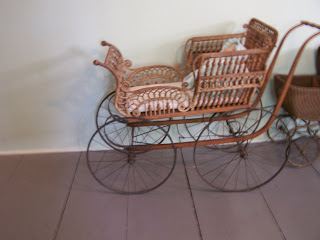Hello there!
How excited I am to sharing more of my visit to the Samuel Parsons House in Wallingford, Connecticut! Check
here for more information on the architecture and some historical aspects of the house that are beyond my scope of explaining. First of all, before entering the house, here are some things you will notice outside....
 |
| Stone mile marker with Roman numerals telling you it is 11 mile to New Haven, CT. |
 |
| Bullseye Glass in the Windows in windows of the front doors |
|
 |
| Pink Granite Stone Steps to step in and out of a horse-drawn carriage. |
Bullseye Glass was actually a waste product from the process of how window glass was made in those days. Since yankee ingenuity kept people from letting anything go to waste, it was used decoratively, such as in the front doors here. It still let the light through. Now, bullseye glass is quite sought after for it's decorative looks and because of how the glass was made. You can read this
link to learn more about how that glass was made.
| | | | The granite set of steps to get in and out of a carriage was something that impressed me. Back when those were made, there may or may not have been sidewalks in town, but the roads were made of dirt. Especially for ladies in their long dresses and skirts with shoes that weren't made with any practicality in mind for the conditions of dust, dirt, rain, this set of steps must have been a godsend!
 |
| Inside View of Bullseye Glass |
| | | |
|
|
|
|
|
|
|
|
|
Upon entering the house you can see how the bullseye glass looks from the inside. It helped bring extra light into the house. You walk into a hallway with a central staircase. If you take a right into the first room, you can see the house as it may have looked when it was a tavern. People would take in borders or have food available to serve travelers and provide lodging to bring in extra money. The room may have also served as a tearoom. The colors the room is painted is based on some research at
Olde Sturbridge Village and also from layers of paint found during the restoration process to be historically accurate.
 |
| Notice the glass in the mirror is not smooth, giving a wavy reflection. |
The windows are large to let in lots of light and are made of many small panes holding together smaller pieces of glass. They didn't use larger pieces of glasses due to how easily the glass in colonial days would break and couldn't be made as large as modern day. Wood panes made it much stronger.
Women would keep their work with them handy. One couldn't just run to the store for clothing. In early America, linens such as napkins, tablecloths, bed linens and the like were much more valuable in worth than the furniture of the house. This is due to everything had to be made by hand-the thread from spinning, the cloth from weaving, the clothes from hand sewing.
 |
| A Small spinning wheel to spin flax for linen |
 |
| How a table may have looked to serve the food for lodgers and travelers. It is in the room just adjacent to the kitchen. |
|
|
|
 | Something I find interesting is that tea cups didn't always have handles in Western civilization! If this was explained to me correctly, the tea was poured from cup while it was very hot into the saucer. It would be cooler to drink from the saucer. | |
| Teacup made before they had handles | I will research this and correct this if it's inaccurate. |
|
|
|
I will continue with this in my next edition of this! I do try to research things to be accurate. If you find discrepancies or have any other thoughts or comments, please share in the comments section! I am very open to hear what you have to say. I also will correct inaccuracies, if any, as I find them out.
I do thank you for joining me and allowing me to share this with you. Please comment. Also, if you liked this, please share it with others!
Thanks! I hope you have a wonderful day!
Mary Ellen



































